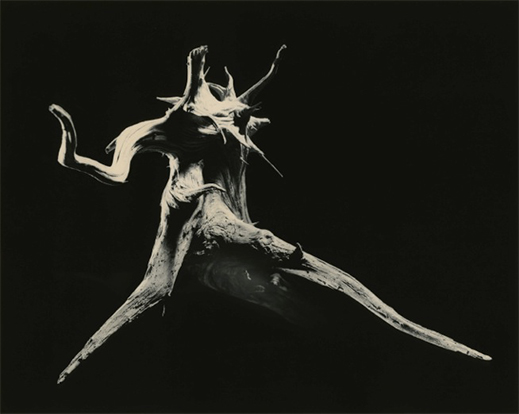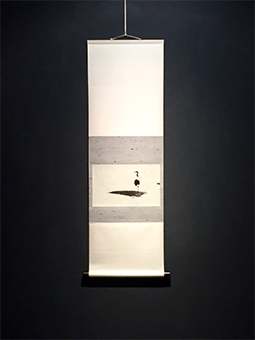 |
|
Here and There introduces art, artists, galleries and museums around Japan that non-Japanese readers and first-time visitors may find of particular interest. The writer claims no art expertise, just a subjective viewpoint acquired over many years' residence in Japan.
|
|
 |
|
|
 |
 |
A Tree as Lovely as a Poem: Masao Yamamoto's Bonsai Photographs
Alan Gleason |
 |
"#4000" from the BONSAI series, ed. 10, gelatin silver print, 258 x 337 mm. |
Born in Aichi Prefecture in 1957, Masao Yamamoto began his artistic career as an oil painter, but for over 30 years now he has made his name as a photographer admired for his lyrical and meditative monochrome work. He likes to discuss his practice in terms of haiku and Zen, and there is certainly something satisfyingly shibui about the subdued flavor of his studies in black and white. But there is also a sizable dollop of humor and optical trickery. BONSAI, a new series currently showing at Tokyo's Mizuma Art Gallery, achieves a sublime balance between these dual impulses toward austerity and play.
"#4022" from the BONSAI series, ed. 10, gelatin silver print, 258 x 337 mm. |
The miniature trees that are the subjects of these photos are themselves works of art, created by Minoru Akiyama, a Tokyo neighbor of Yamamoto who happens to be one of today's most celebrated bonsai artists. Essentially this series is a collaboration between the two men. Akiyama's trees -- black pine, juniper, persimmon, wild plum, maple, and more -- range from 10 to 100 centimeters in height; some are several hundred years old. Though his compositions include the familiar twisting pines with their carefully trimmed tufts of foliage, Akiyama seems to favor desiccated, husk-like trunks that bring to mind the gnarled bristlecone pines -- the world's oldest living trees-- that dot the higher elevations of the California Sierra.
|
"#4001" from the BONSAI series, ed. 10, gelatin silver print, 337 x 258 mm.
|
|
"#4007" from the BONSAI series, ed. 10, gelatin silver print, 337 x 258 mm. |
Yamamoto has selected a number of Akiyama's bonsai and placed them against dramatic outdoor backdrops -- a lake, a mountain range, a starry night, Mt. Fuji -- shooting from low angles with the trees in close foreground so that they look convincingly full-size in a natural environment. Of course Yamamoto lets the viewer in on the ruse (the bonsai pot is usually in prominent view), but he obviously enjoys playing with the artistic possibilities of such trompe-l'oeil arrangements. Many of the images have the tree backlit by a low-hanging sun, or are taken in darkness with a diffuse light source that gives the bonsai an eerie glow. There is no photoshopping going on here, but some of the juxtapositions are so gleefully contrived that one can't be blamed for suspecting as much.
"#4008" from the BONSAI series, ed. 10, gelatin silver print, 258 x 337 mm. |
"#4018" from the BONSAI series, ed. 10, gelatin silver print, 258 x 337 mm. |
The resulting photographs are, in any event, things of beauty, highlighting not only the bonsai themselves but also the settings Yamamoto has chosen for them. Even more conspicuously, though, they showcase the photographer's stunning way with the monochrome palette.
Rounding out the exhibition are several works from two earlier series: Tori (Birds) and Shizuka=Cleanse. The latter, which features close-ups of curiously shaped roots and rocks, showed at Mizuma exactly four years ago (see Here and There's review here). These unadorned portraits of natural objects betray none of the artifice on display in the BONSAI series, and are all the stronger for it. For this reason, perhaps, the eye is immediately drawn to this smaller selection of prints. For the current show Yamamoto has selected motifs that are indubitably anthropomorphic, notably "Dance 'W'," a leggy snag of root that is the spitting image of what one imagines to be a butoh dancer.
 |
|
"#3029, Dance 'W'" from the Shizuka=Cleanse series, ed. 25, gelatin silver print, 450 x 560 mm. |
"#1678" from the Tori series, ed. 20, pigment print on handmade washi paper, 203 x 334 mm. |
The works from Tori also contrast with BONSAI in a fashion that gives food for thought. As the title suggests, the images are of birds, but in highly unorthodox poses or settings: a flock of hawks occupying the branches of a bare tree; two geese in symmetric embrace; a solitary crane in a wintry landscape. Two prints sharing this last motif stand out for their uncanny resemblance to sumi-ink Zen paintings. In "#1678," the bird stands in profile at one end of a long streak of black -- a bare patch of ground in the snow? -- that cuts across the otherwise all-white picture plane like a slash of the calligrapher's brush. Only a few pale stalks of shrubbery in the background reveal that the white expanse is actually a snow-covered field.
|
 |
|
|
|
"#1655" from the Tori series, ed. 5, 165 x 242 mm, pigment print on handmade washi paper mounted on silk scroll, hangs in the tokonoma alcove of Mizuma Art Gallery. Photo by Alan Gleason
|
It's always fun to see how artists exhibiting at Mizuma choose to utilize the gallery's unique tokonoma space, a dimly lit alcove with indigo walls and tatami flooring in which they are encouraged to place a work where a scroll painting would normally go. Yamamoto has opted for a traditional approach, hanging a scroll that frames a second photograph ("#1655"), printed on washi paper, of a crane standing on a dark patch amid the snow. Works like these, too, toy with optical illusion -- in this case, as photographic images that are indistinguishable from classical sumi paintings.
On a first pass through the exhibition, it is most likely the cleverness of Yamamoto's compositional strategies that will catch the eye. A second look around is in order, however, to fully appreciate the beauty of these works.
All images © Masao Yamamoto, courtesy of Mizuma Art Gallery. |
 |
| Masao Yamamoto / BONSAI: A droplet in the hand |
| 16 January - 16 February 2019 |
| Mizuma Art Gallery |
2F Kagura Bldg., 3-13 Ichigaya-tamachi, Shinjuku-ku, Tokyo
Phone: 03-3268-2500
Hours: 11 a.m. - 7 p.m.
Closed Sundays, Mondays, and national holidays
Access: 5 minutes' walk from Tokyo Metro Ichigaya Station, exit 5 (Yurakucho and Nanboku Lines); 8 minutes' walk from JR Iidabashi Station, west exit (Sobu Line)
|
|
|
|
| |
 |
Alan Gleason
Alan Gleason is a translator, editor and writer based in Tokyo, where he has lived for over 30 years. In addition to writing about the Japanese art scene he has edited and translated works on Japanese theater (from kabuki to the avant-garde) and music (both traditional and contemporary). |
|
|
|
|
|
|
|
|
|
 |
|